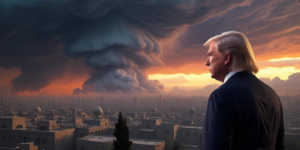Everything You Need to Know About Trump’s Weekend Meeting With North Korea’s Kim Jong Un
When nuclear talks resume after Sunday’s off-the-cuff meeting between U.S. President Donald Trump and North Korean leader Kim Jong Un at the inter-Korean border, negotiators will be revisiting old disagreements that have scuttled previous talks.
Trump and Kim agreed to set up teams to hold working-level talks, which have stalled since a second summit in February in Vietnamese capital Hanoi failed to agree on U.S. calls for denuclearisation and North Korean demands for sanctions relief.
The brief weekend meeting broke a recent pattern of increasing threats and complaints from North Korea, and the two sides will enter the talks with renewed backing from their leaders.
North Korea’s state media KCNA lauded Sunday’s meeting, saying Kim and Trump vowed to continue dialog to make a “new breakthrough” in the denuclearisation of the Korean peninsula and in bilateral ties.
But there are still formidable differences, including whether denuclearisation or normalizing ties should come first, and how much North Korea is actually willing to give up.
DISAGREEMENTS EXPOSED
In Hanoi, Trump sought the abolition of all of the North’s nuclear installations, including shipping of the weapons and material to the United States, while Kim offered to close its main Yongbyon nuclear complex in return for sanctions relief.
There has been little sign that North Korea and the United States are any closer to resolving differences on how to achieve denuclearisation and when and which sanctions should be lifted.
Perhaps most fundamentally, the sides lack a shared definition of denuclearisation, with Pyongyang discussing it in terms of removing the threat of nuclear weapons from the entire Korean peninsula.
Some experts have said Trump made a mistake at his first summit with Kim in Singapore last year by allowing their promise to build “new relations” a top priority in their joint statement, whereas denuclearisation comes in third.
The New York Times, citing unidentified sources, reported on Monday that Washington is seeking to soften its approach, floating an idea of accepting a nuclear freeze—instead of complete dismantlement—and giving tacit recognition that North Korea is a nuclear state.
Reuters was unable to independently verify the report.
NUCLEAR SITE PROPOSAL
One of the most visible parts of North Korea’s nuclear program, the Yongbyon reactor complex is a central point of contention.
After the Hanoi summit ended without a deal, North Korean foreign ministry officials said they had made a “historically unprecedented offer” to close all of Yongbyon together with U.S. experts.
U.S. negotiators confirmed North Korea had made the offer, but said talks broke down over exactly which facilities were included, and the scope of sanctions relief that Pyongyang demanded in return.
Even if the revived working level talks lead to Yongbyon’s closure, the process is likely to take years, well after Trump’s term ends.
South Korean officials say that dismantling the site would be a major blow to North Korea’s nuclear program, though experts warn that Pyongyang has built a wide number of other, clandestine sites that could allow it to keep some nuclear capabilities.
NEW NORTH KOREAN NEGOTIATORS
U.S. Secretary of State Mike Pompeo said a fresh round of talks will likely happen in mid-July, which would be led by Stephen Biegun, special envoy for North Korea, and Pyongyang’s foreign ministry officials, without specifying.
The diplomats would take over from Kim Yong Chol, a hardline military general, who steered negotiations in the run-up to the Hanoi summit.
The new North Korean lineup could mean better chances of working through denuclearisation, analysts said.
Foreign Minister Ri Yong Ho and his deputy, Choe Son Hui, are seasoned diplomats with expertise in the nuclear issues and experience in working with U.S. officials.
The diplomats have gained trust from Kim since the failed summit, but the final decision maker remains Kim Jong Un, who has shunned grueling working-level talks in favor of dealing directly with Trump.
WHAT DOES NORTH KOREA WANT?
North Korea has publicly called for an end to the crippling economic sanctions imposed by the United States and the United Nations.
An initial step might include formally ending the 1950-53 Korean War and setting up liaison offices.
North Korea has also long called for a peace deal with the United States to normalize relations and end the technical state of war that has existed since the 1950-53 Korean War concluded with an armistice rather than a peace treaty.
South Korea has also said re-opening the Kaesong industrial park and tours to Mount Kumgang, two inter-Korean projects closed as tensions ramped up, could expedite the North’s denuclearisation.
© 2019 Thomson Reuters. All rights reserved.




























































